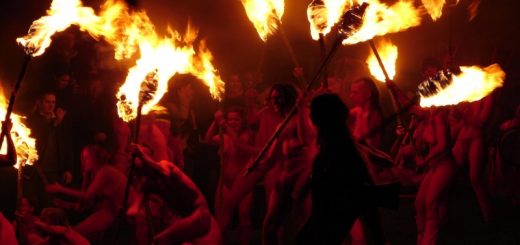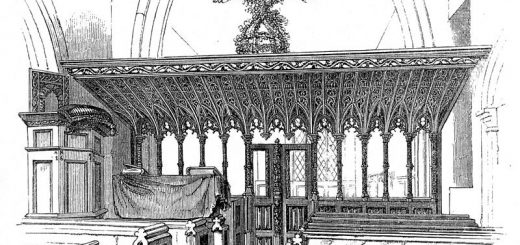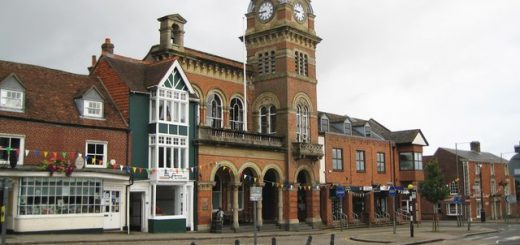St Mark’s Eve
24 April – The feast day of St Mark the Evangelist (founder of the Church of Alexandria) falls on 25th April, but there are some interesting folk customs that fall on the eve of the feast.
Divining Who Is To Die
Between the 17th and 19th century it was thought that holding a vigil in a church porch during the hours of 11.00pm through to 1.00am on three successive years would reveal the identities of those due to die and be buried in the churchyard over the coming year as their apparitions (or coffins or headless corpses depending on the source) entered the church in procession. This was a tradition throughout Britain though probably more popular in the North and West. It is no wonder then that there are variations on the tradition. Some accounts say this vigil must be repeated each year of your live instead of just three. Others say the exterior of church had to walked around before the vigil begins and some say that those undertaking the task had to be fasting.
‘Tis now, replied the village belle,
St. Mark’s mysterious eve,
And all that old traditions tell
I tremblingly believe;
How, when the midnight signal tolls,
Along the churchyard green,
A mournful train of sentenced souls
In winding-sheets are seen.
The ghosts of all whom death shall doom
Within the coming year,
In pale procession walk the gloom,
Amid the silence drear.’
Divining For Future Husbands
St Marks Eve was also the time when young maids would try to use divination to discover the identity of their true love and husband to be. One method was to hang their smock before the fireplace and await for the arrival of an apparition of the man your due to marry to come in and turn it for you.
On St. Mark’s eve, at twelve o’clock,
The fair maid will watch her smock,
To find her husband in the dark,
By praying unto good St. Mark.’
In North Kelsey, Lincolnshire young women would visit the Maiden Well on St Marks Eve. ‘Girls coming to the spring with the view of divination must walk towards it backwards, and go round it three times in the same manner, each girl, meanwhile, wishing the wish that she may see her destined sweetheart. After the third circle is complete, the inquirer must kneel down and gaze into the spring, in which she will see her lover looking up out of the depths.’
(County Folk-Lore by Gutch and Peacock,1908)
Another method of employed by young women was to place a nut by the heath and whisper the name of the man they believe may be their true love. If the nut jumped from the fire then the love was meant to be.




Re: St Mark’s Eve
‘Haunted Churches’ (1939), Elliott O’Donnell (27 February 1872 – 8 May 1965)
Reference has already been made in this book to the belief in some counties that if a person keeps watch in a certain church porch, on St. Mark’s Eve (April 24), for an hour on each side of midnight for three successive years (some consider one year is sufficient), he will see the forms of those doomed to die within the next twelve months pass, one by one, into the church. In Yorkshire it is further believed that if the watcher falls asleep during his vigil, he will die himself in the course of the year. An authentic case of a St. Mark’s Eve vigil is related by Mr. William Henderson. On St. Mark’s Eve, 1786, an old woman of Scarborough went to the porch of St. Mary’s church in order to see into the future. On the stroke of midnight " figure after figure glided into the church, turning round to her as they went on, so that she recognised their familiar faces. At last a figure turned and gazed at her ; she knew herself, screamed, and fell senseless to the ground, but she did not long survive the shock." Mr. Henderson goes on to say : " An old man, who recently died at Fishlake, in the West Riding of Yorkshire, was in the habit of keeping these vigils, and was, in consequence, an object of some dread to his neighbours. I have heard of the rite in Cleveland too, and at Teesdale, and one instance has come before me at Ford in Northumberland . “
According to ‘The Folklore Of Lincolnshire by Mabel Peacock (December 1900).’ On the Eve of St. Agnes, the Eve of St. Mark, and Hallow-E’en, various rites are practised to obtain a glimpse of the spirit of the husband who has been allotted to a girl by immutable destiny, or to ensure a dream in which he must show himself. With this object “dumbcake ” may be prepared and eaten with the appropriate observances, a supper may be set out to allure the man’s spirit, sage may be gathered to compel his appearance, or other spells may be used.
Most of the stories connected with this kind of divination have a bad ending, and there is little doubt that young girls frequently allow themselves to be led astray from the conviction that the,”true love ” revealed to them by occult means is bound to marry them by a fore-doomed fate from which there is no escape.
According to ‘The Folklore Of Lincolnshire by Mabel Peacock (December 1900).’ It is difficult to determine whether anyone .now watches the, porch of the church on St. Mark’s Eve, to see the spirits of all “the parishioners enter the building. But various accounts of this practice as it was observed sixty years ago are still current. “The folks to be married came out arm-in-arm,” says one story, “and those who were to die within the next twelve months never came out at all.” Unless they are summoned by love-spells, or watched for at the church porch, the spirits of living men and women rarely appear, though they have at times been seen by persons gifted with what the Scotch term ” second sight,” a faculty which, according to my experience, is but rarely heard of in Lincolnshire.